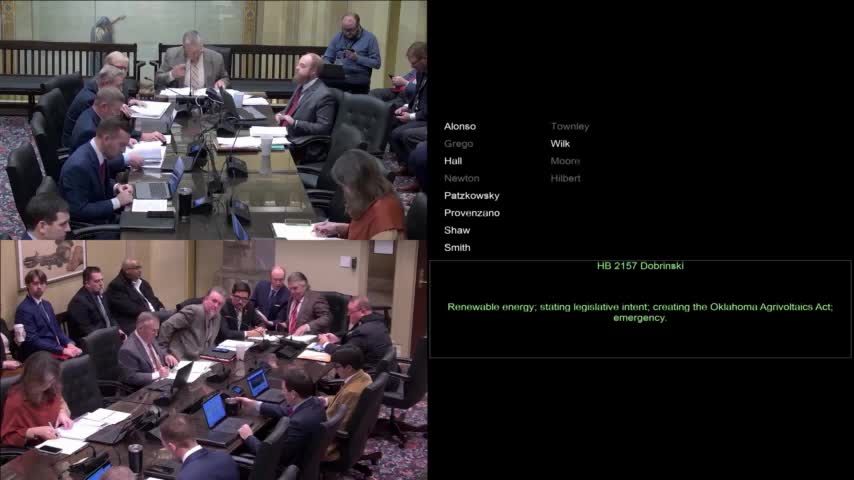House committee advances Oklahoma Agrivoltaics Act after debate on farm benefits and energy reliability
February 10, 2025 | 2025 Legislature OK, Oklahoma
This article was created by AI summarizing key points discussed. AI makes mistakes, so for full details and context, please refer to the video of the full meeting. Please report any errors so we can fix them. Report an error »

A House committee on Monday reported out House Bill 2157, the Oklahoma Agrivoltaics Act, after members debated whether combining solar production with continued agricultural use can preserve farmland and deliver benefits to producers.
Supporters said agrivoltaics — siting photovoltaic arrays to allow farming or grazing beneath or between panels — can keep land in production while accommodating new renewable projects. “Agriculture activity along with solar production can take place simultaneously,” a bill sponsor said during the committee hearing, calling the measure “a step toward trying to better manage” where new generation is located.
Why it matters: Lawmakers said the state is seeing rapid growth in renewable projects, some developed by out-of-state firms that build and sell generation sites, which can permanently remove farmland from production if panels occupy the entire footprint. The bill would create mechanisms to encourage dual-use projects that allow continued crop or livestock production under or around panels.
Committee questioning focused on two topics: whether renewables are sufficiently reliable to expand, and what concrete benefits farmers would see. “Wind and solar have been largely affirmed as being intermittent and unreliable energy,” Representative Shaw said, asking why the bill would promote “the advancement of unreliable energy in our state.” The sponsor answered that the bill is not about proving reliability but about managing where projects are built and creating options for co‑production on agricultural land.
Lawmakers also outlined potential on‑farm uses. “Imagine a solar panel over a big dairy farm. We power the dairy, have shade for the dairy cattle. Farmer likes it, generates electricity,” Representative Patzkowski said, offering an example of how agrivoltaics could reduce on‑farm energy costs and provide shade for animals.
Representative Alonzo Sandoval asked about direct benefits to farmers. “Could this potentially help a farmer, a rancher, by producing energy? Does that lower their electricity bill?” he asked. The sponsor replied that, while the bill’s primary goal is to preserve agricultural production, any cost reductions for ratepayers would be an additional benefit but depend on project specifics.
The committee approved the bill to report it out to oversight by a 7‑2 vote. The chair instructed the sponsor to secure a Senate author before the oversight hearing.
Votes and outcome: The committee reported the bill out with seven yeas and two nays; the record includes at least one recorded aye: Moore.
Background and next steps: The sponsor described the measure as “a work in progress” developed after constituent outreach and consultation with conservation groups. The committee’s approval sends the bill to an oversight committee; the sponsor was told to secure a Senate author before that hearing.
Ending: The committee’s report means HB 2157 will continue in the legislative process; the bill’s proponents said they will refine details on siting, agricultural practices allowed, and incentives to encourage dual‑use projects.
Supporters said agrivoltaics — siting photovoltaic arrays to allow farming or grazing beneath or between panels — can keep land in production while accommodating new renewable projects. “Agriculture activity along with solar production can take place simultaneously,” a bill sponsor said during the committee hearing, calling the measure “a step toward trying to better manage” where new generation is located.
Why it matters: Lawmakers said the state is seeing rapid growth in renewable projects, some developed by out-of-state firms that build and sell generation sites, which can permanently remove farmland from production if panels occupy the entire footprint. The bill would create mechanisms to encourage dual-use projects that allow continued crop or livestock production under or around panels.
Committee questioning focused on two topics: whether renewables are sufficiently reliable to expand, and what concrete benefits farmers would see. “Wind and solar have been largely affirmed as being intermittent and unreliable energy,” Representative Shaw said, asking why the bill would promote “the advancement of unreliable energy in our state.” The sponsor answered that the bill is not about proving reliability but about managing where projects are built and creating options for co‑production on agricultural land.
Lawmakers also outlined potential on‑farm uses. “Imagine a solar panel over a big dairy farm. We power the dairy, have shade for the dairy cattle. Farmer likes it, generates electricity,” Representative Patzkowski said, offering an example of how agrivoltaics could reduce on‑farm energy costs and provide shade for animals.
Representative Alonzo Sandoval asked about direct benefits to farmers. “Could this potentially help a farmer, a rancher, by producing energy? Does that lower their electricity bill?” he asked. The sponsor replied that, while the bill’s primary goal is to preserve agricultural production, any cost reductions for ratepayers would be an additional benefit but depend on project specifics.
The committee approved the bill to report it out to oversight by a 7‑2 vote. The chair instructed the sponsor to secure a Senate author before the oversight hearing.
Votes and outcome: The committee reported the bill out with seven yeas and two nays; the record includes at least one recorded aye: Moore.
Background and next steps: The sponsor described the measure as “a work in progress” developed after constituent outreach and consultation with conservation groups. The committee’s approval sends the bill to an oversight committee; the sponsor was told to secure a Senate author before that hearing.
Ending: The committee’s report means HB 2157 will continue in the legislative process; the bill’s proponents said they will refine details on siting, agricultural practices allowed, and incentives to encourage dual‑use projects.
View full meeting
This article is based on a recent meeting—watch the full video and explore the complete transcript for deeper insights into the discussion.
View full meeting
